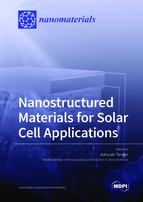Nanostructured Materials for Solar Cell Applications
A special issue of Nanomaterials (ISSN 2079-4991). This special issue belongs to the section "Solar Energy and Solar Cells".
Deadline for manuscript submissions: closed (30 September 2021) | Viewed by 27137
Special Issue Editor
Special Issue Information
Dear Colleagues,
The use of nanomaterials in technologies for photovoltaic applications continues to represent an important area of research. There are numerous mechanisms by which the incorporation of nanomaterials can improve device performance. We invite authors to contribute original research articles or comprehensive review articles covering the most recent progress and new developments in the design and utilization of nanomaterials for highly efficient, novel devices relevant to solar cell applications. This special issue aims to cover a broad range of subjects, from nanomaterials synthesis to the design and characterization of photovoltaic devices and technologies with nanomaterial integration. The format of welcomed articles includes full papers, communications, and reviews.
Prof. Dr. Katsuaki Tanabe
Guest Editor
Manuscript Submission Information
Manuscripts should be submitted online at www.mdpi.com by registering and logging in to this website. Once you are registered, click here to go to the submission form. Manuscripts can be submitted until the deadline. All submissions that pass pre-check are peer-reviewed. Accepted papers will be published continuously in the journal (as soon as accepted) and will be listed together on the special issue website. Research articles, review articles as well as short communications are invited. For planned papers, a title and short abstract (about 100 words) can be sent to the Editorial Office for announcement on this website.
Submitted manuscripts should not have been published previously, nor be under consideration for publication elsewhere (except conference proceedings papers). All manuscripts are thoroughly refereed through a single-blind peer-review process. A guide for authors and other relevant information for submission of manuscripts is available on the Instructions for Authors page. Nanomaterials is an international peer-reviewed open access semimonthly journal published by MDPI.
Please visit the Instructions for Authors page before submitting a manuscript. The Article Processing Charge (APC) for publication in this open access journal is 2900 CHF (Swiss Francs). Submitted papers should be well formatted and use good English. Authors may use MDPI's English editing service prior to publication or during author revisions.
Keywords
- photovoltaics and photocatalysts
- nanomaterials, nanostructures, and nanophotonics
- quantum wells, wires, and dots
- photonic and plasmonic nanostructures
- surfaces and interfaces
- nanoscale fabrication and characterization technologies







